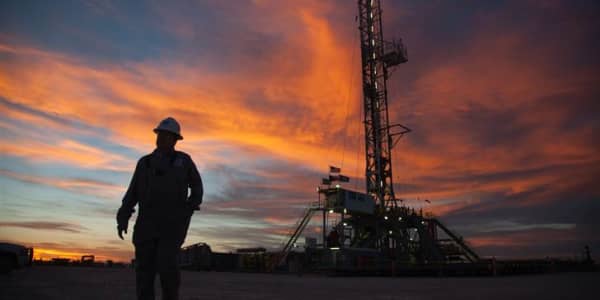Mike Lennox, district manager with the energy exploration firm Helmerich and Payne, drives his pickup toward Rig 312, about 7 miles southeast of Garden City, Texas, (population 312). The drilling rig is one of thousands seeking oil in the Permian Basin, an oil-and-gas-producing area located in West Texas and part of New Mexico. H&P, which is subcontracting for Laredo Petroleum, is drilling the well, then will pull out and turn the operation to a "fracking" subcontractor before Laredo begins harvesting the oil.
A new polycrystalline diamond compact (PDC) bit rests on the deck of the rig. Bits such as these can cost as much as $75,000. On this particular drilling operation, H&P will use as many as four or five different bits to bore through different layers of rock.
(Read More: U.S. Oil and Gas Boom Takes Many by Surprise)
Rig workers prepare to lower the bit, which is affixed to the bottom hole assembly. For this well, contracted by Laredo Petroleum, they're drilling straight down 7,038 feet; then making a 90-degree turn and drilling horizontally another 7,387 feet.
From left to right, derrick man Justin Wilson, floor hand Homer Reid, floor hand Tony Spatola (standing behind mud motor), and motor man Patrick Line affix a hole opener and stabilizer to the bottom hole assembly.
(Watch: Residents Welcome New West Texas Energy Boom, While It Lasts)
Floor hand Homer Reid controls a cable to help guide a section of pipe up to the rig's drilling platform from the ground, 25 feet below.
(Read More: Audi on a Roll: Automaker Setting Annual Sales Records)
90-foot sections of pipe (assembled from three 30-foot sections) will be attached and used to help push the bit further into the Permian Basin.
(Read More: BP Challenges Ruling on Oil Spill Compensation)
Driller Clint Arrington controls the progress of the drilling using an array of touch screens inside the driller's house on Rig 312. From where he sits, Arrington can monitor pump pressures, rate of penetration, engine loads, weight on the bit, torque and more. An operation like this doesn't come cheap. A well like this can cost $8 million or more to drill.
Rig manager James Brown overlooks the reserve holding area for fresh water and mud. Water plays an intergral role in drilling -- it's mixed with chemicals and pumped through the bit to lubricate and cool it and to bring cuttings back to the surface. The water, which either comes from a nearby well or is hauled in by trucks, is sometimes recycled and used from well to well. The large, red tank is a gas separator, which captures any natural gas that may seep out of the well with the drilling fluids.
H&P representative Armando Acevedo passes a storage unit plastered with safety messages. Advancements in drilling technology mean that machines now perform many of the tasks that previously presented safety hazards to rig workers.
(Read More: Propane: It's Not Just for Barbecues Anymore)
A worker walks from the 161-foot-tall oil rig to retrieve a tool from a nearby shed. On March 3, the day this picture was made, there were 1,752 rigs exploring for oil and natural gas in the U.S.; 835 of them were in Texas, according to the Midland Reporter-Telegram.





